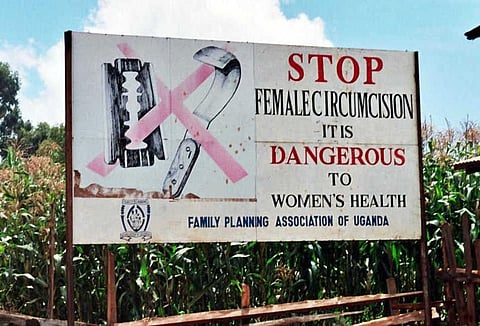
- Home
- न्यूजग्राम
- NewsGram USA
- India
- World
- Politics
- Entertainment
- Culture
- Lifestyle
- Economy
- Sports
- Sp. Coverage
- Misc.
- NewsGram Exclusive
- Jobs / Internships

"When I got it done for my daughter, I did it because it was a custom to be followed" said Sophie Johari to a newspaper. Aarefa Johari (29), journalist with Scroll.in and co-founder of SAHIYO, an organisation against FGM, was the unfortunate child of 7 years who had to go through the traumatic procedure of 'khatna'. Her mother regrets not standing up for her daughter then and now supports her campaign on Facebook.
What is Female Genital Mutilation (FGM)?
According to WHO, Female genital mutilation (FGM) comprises all procedures that involve partial or total removal of the external female genitalia, or other injury to the female genital organs for non-medical reasons. Also according to their report more than 200 million girls and women alive today have been cut in 30 countries and is mostly carried out on young girls between infancy and age 15.
Why is it practised?
In her book 'The Hidden Face of Eve', Nawal El-Saadawi, a Muslim victim of infibulation(a type of circumcision in which external genitalia is removed and the opening is sewn for bodily discharges) says," Behind circumcision lies the belief that, by removing parts of girls' external genitals organs, sexual desire is minimized. This permits a female who has reached the dangerous age of puberty and adolescence to protect her virginity and therefore her honor, with greater ease. Female circumcision is meant to preserve the chastity of young girls by reducing their desire for sexual intercourse."
Debates on Male Circumcision vs. Female Genital Mutilation
Male circumcision has been a reality for hundreds of years in the name of tradition and religion for many Jewish and Islamic families. It has been a topic a global discussion that since circumcision is an unnecessary invasive surgery performed on un-consenting children, why is female genital mutilation criticized and male circumcision condoned. Aren't both supposed to be equally wrong? Why is one illegal while the other is not?
The biggest difference between male and female circumcision is the amount of tissue that is being removed in the process along with the conditions in which the process is being carried out. Mostly in male circumcision, part or all of his foreskin is removed or the tissue(frenulum) connecting the foreskin to the penis is removed whereas in FGM, entire clitoris maybe removed. Circumcision is usually carried out by or in presence of a medical practitioner whereas FGM is an undercover activity performed in an unhygienic manner by untrained midwives. But this generalization may not be true in every case since incidents of deadly male circumcisions have been reported.
Knives used for FGM: Wikimedia Commons
Some sociologists and ethicist even disagree with the argument of attributing FGM with patriarchy and say it over- simplifies the social and cultural causes of the process. Throughout much of Africa, it is practiced around puberty for both boys and girls alike.
Where is FGM practised?
Female Genital Mutilation is most prevalent in Africa, Egypt being the country with the highest number of cases. It is also practised in some parts of Middle East and Asia. In India, the practice is followed among the Dawoodi Bohra community, based primarily in states of Gujarat and Maharashtra. Bhendi bazaar district in Mumbai is where the major Bohra Muslim population lives.
Who are Bohra Muslims?
Bohra is a Gujarati-speaking caste originated from Kutch area of India. These were predominantly a business community, some of whom converted to Islam. There was a dispute in leadership in the 16thcentury AD and the ones who chose to accept Dawood ibn Qutubshah Burhanudeen as their leader came to be known as Dawoodi Bohras. Their spiritual leader is called as 'Syedna'. The community is well reputed for being progressive traders and wealthy. The current Syedna has close ties with Prime Minister Narendra Modi.
The spokesperson of Syedna Mohammed Burhanuddin has been quoted "Bohra women should understand that our religion advocates the procedure and they should follow it without any argument" on the issue of FGM. As described by a previous article, even the current Syedna in a sermon at the Saifee Mosque in Bhendi Bazaar said "This act has to happen! If it is a man, it can be openly done but if it is a woman, it has to be done discreetly". He did not explicitly mention the act of FGM and left his words open to interpretation.
In India many campaigns are being carried out online and on the grounds to put an end to this barbaric practice. One such effort is undertaken by Masooma Ranalvi and Aarefa Johari in the form of an online petition to Smt. Maneka Gandhi, Minister of Women and Child Development. More about their efforts can be read here.
You can reach the author @ShivangiTripati
